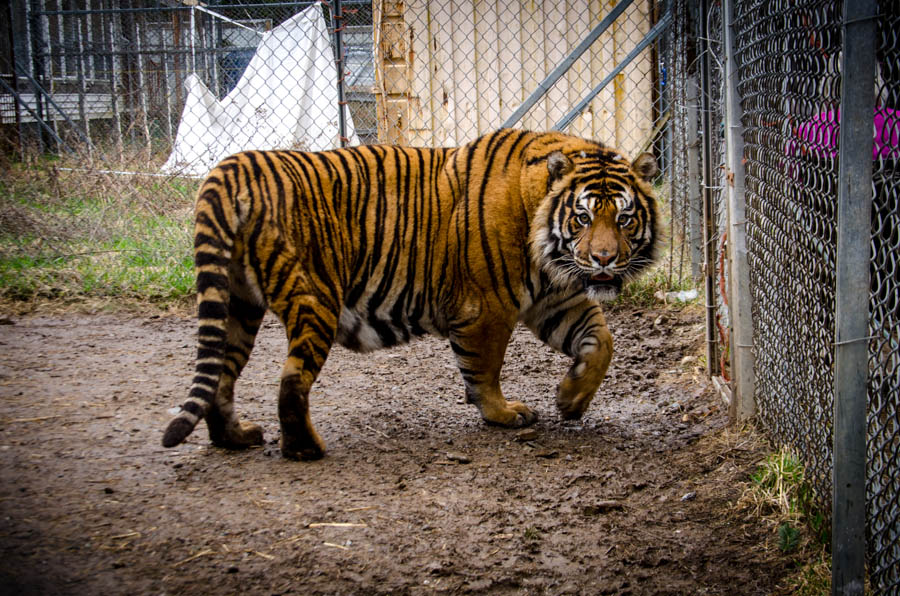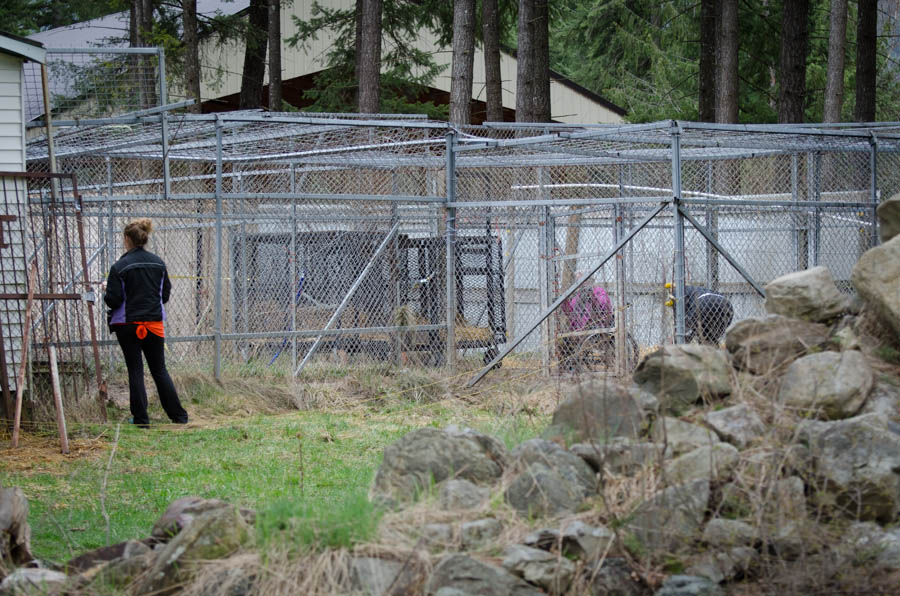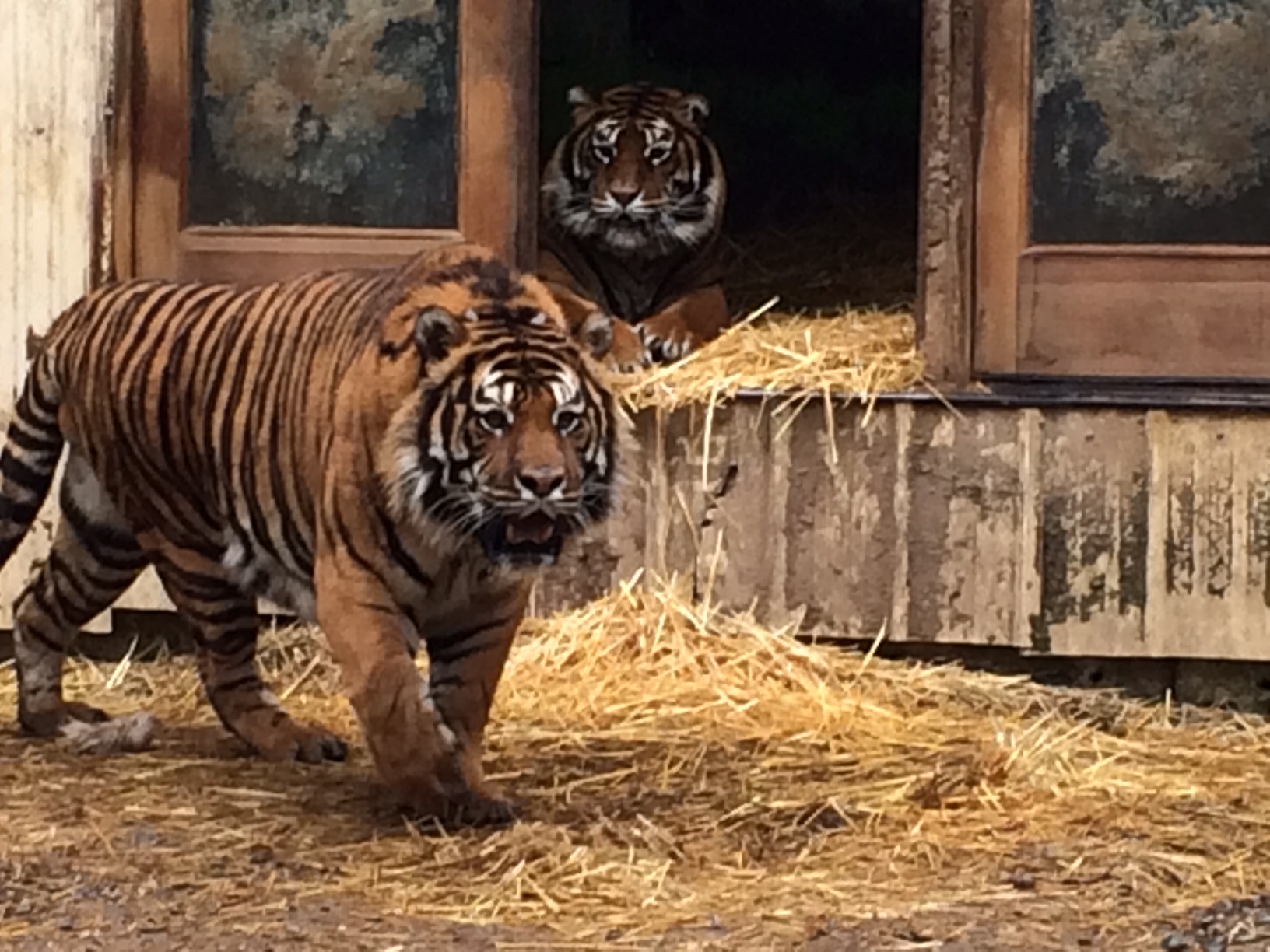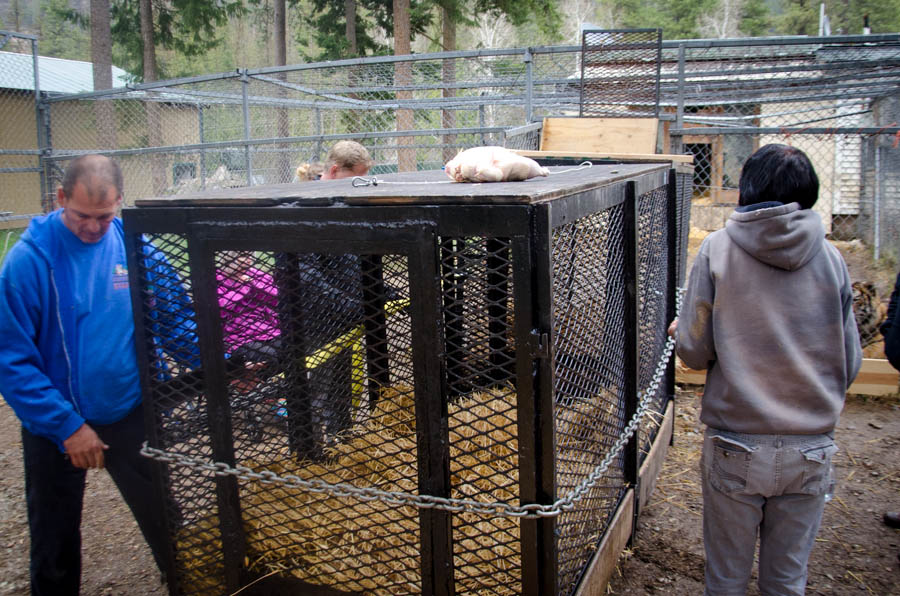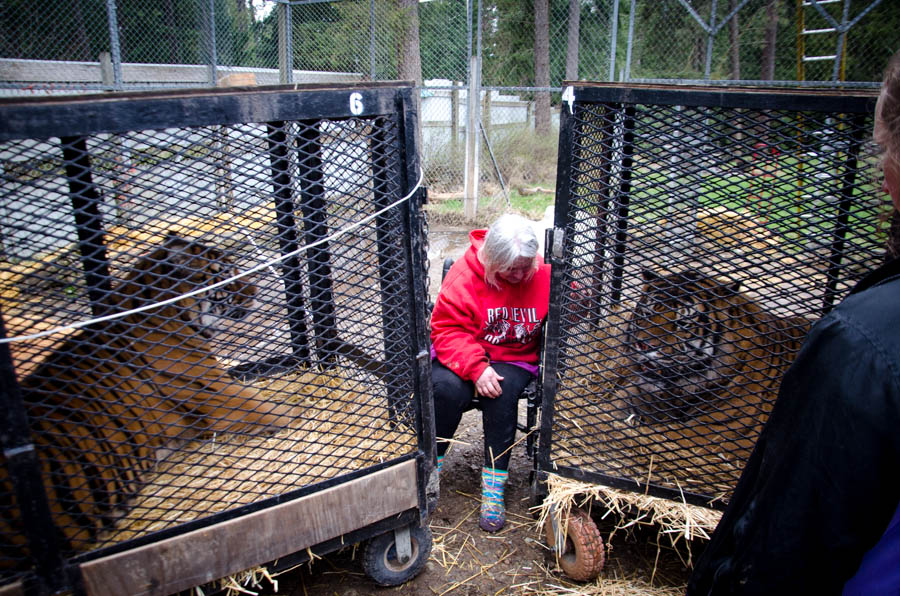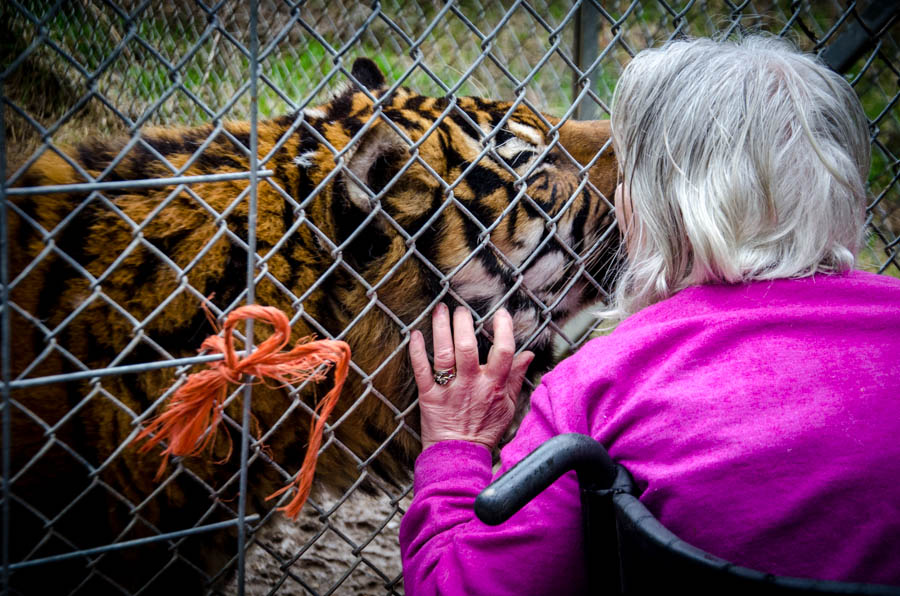The rescue.
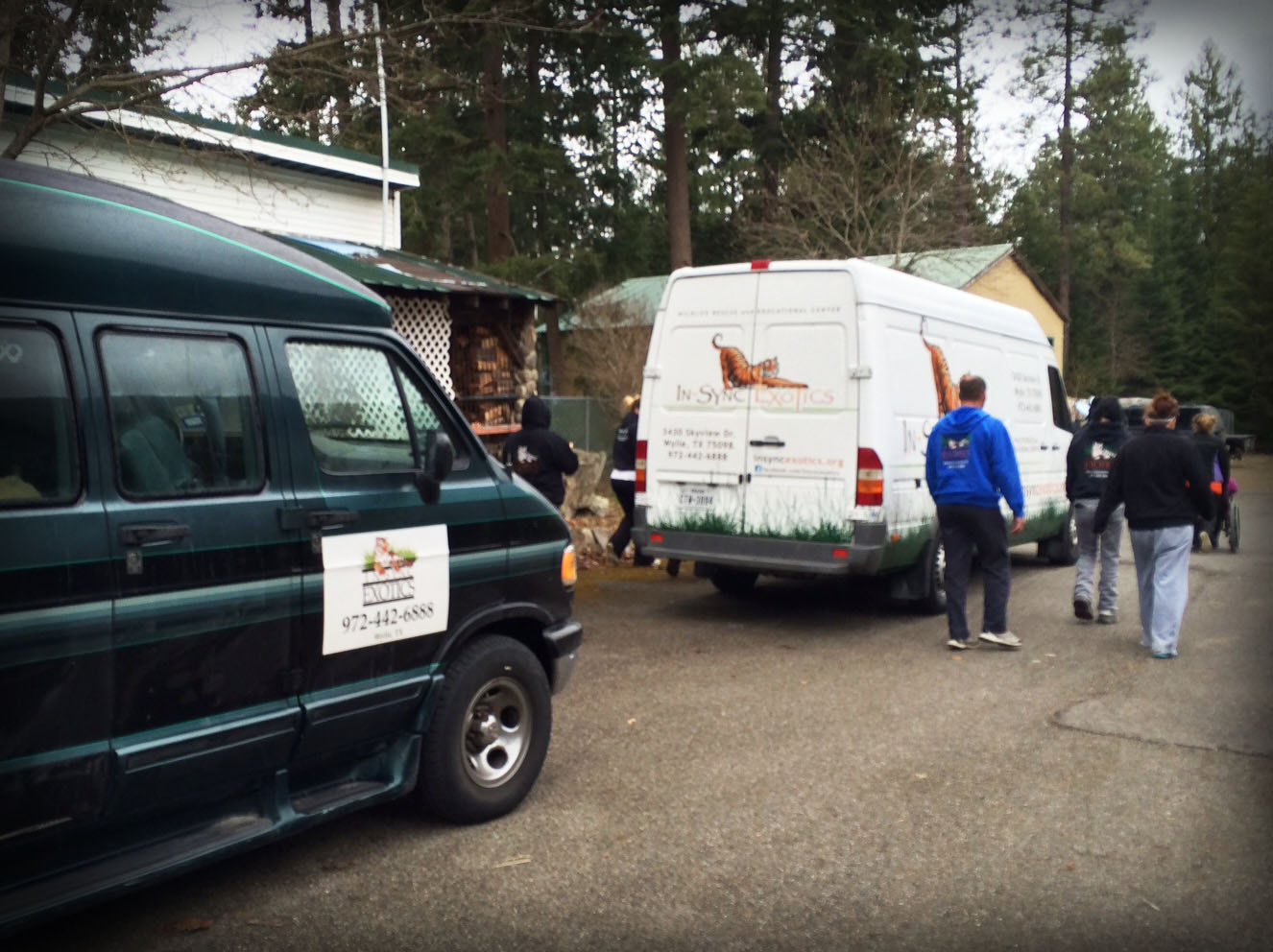 So now it was time to get down to business. The reason we'd driven all the way up to Montana was finally here. It was time to meet the tigers. After a 2000 mile drive we finally reached what was possibly the most dangerous part of our journey. We didn't know what to expect. We were directed down the driveway into an oversized garage. We walked through an open door that led to a side yard. About 20 yards away you could see a ramshackle assemblage of fence panels. While we were trying to assess the situation one of the women said “Watch for the bears that can come from that drop off.” Wait, the first warning we got from the women was not about the tigers but about wild bears? Apparently there were wild bears that lived in the area. Of course. We were in Montana. They would often come up onto the side yard and the older woman would feed them. They said if they came while we were there that we should head over to the porch and let the older woman in the wheelchair wave the bears away. So I'm thinking to myself—not only do we have to watch for 2 tigers and bobcat, but we also have to watch out for wild bears. Great.
So now it was time to get down to business. The reason we'd driven all the way up to Montana was finally here. It was time to meet the tigers. After a 2000 mile drive we finally reached what was possibly the most dangerous part of our journey. We didn't know what to expect. We were directed down the driveway into an oversized garage. We walked through an open door that led to a side yard. About 20 yards away you could see a ramshackle assemblage of fence panels. While we were trying to assess the situation one of the women said “Watch for the bears that can come from that drop off.” Wait, the first warning we got from the women was not about the tigers but about wild bears? Apparently there were wild bears that lived in the area. Of course. We were in Montana. They would often come up onto the side yard and the older woman would feed them. They said if they came while we were there that we should head over to the porch and let the older woman in the wheelchair wave the bears away. So I'm thinking to myself—not only do we have to watch for 2 tigers and bobcat, but we also have to watch out for wild bears. Great.
We walked up to the makeshift enclosure. At that moment a huge tiger walked up to the us and began to chuff and rub his head on the fence panel. A chuff is a sound a tiger makes by closing his mouth and breathing though the nostrils. It is a friendly sound that they make to each other or to their keepers. "This is Morten” she said (We later found out his name was also Mork). Mork was a hefty tiger—no, he was a fat tiger. In most rescues we often find cases of neglect. Cats are often malnourished or have some form of skin condition. They are also not very happy and are distraught and agitated. That was not the case here. It seemed that, if anything, we might be rescuing him from eating too much. Overall, Mork seemed very healthy. Maybe a few pounds too healthy. Three sides of the enclosure were made of chain link fencing. The fourth side was their den which actually looked like it was connected to the main house. There was a small opening right in the middle of the den and back in the shadows we could see another tiger. She was a bit shy and the owner had to coax her out. “This is Mindy”. Mindy looked out but stayed inside. She also looked quite healthy…ok, she was also fat.
The main enclosure itself was about 40"x50”. The panels were 8 foot chain link fencing. The poles we cemented into the ground but you could tell that time has taken its toll so they were loose and flimsy. There was an attempt to cover the enclosure with 4x4 handy panel. That too was in disrepair. In many cases the panels and gates were held together with laces, ribbon or thick string. At the long end of the enclosure was another enclosure about the same size. There was a rectangular man-made pool that was about 5’x20’ and 4 feet deep. This enclosure had 2 gates on each end. I could tell that Stephen was assessing the situation. He began to study the fencing and the various entrances to the enclosure for a place to do the extraction. The regular protocol in these cases is not to sedate the cat. This causes unnecessary stress, and, because we are not familiar with the cat’s medical history, we wouldn’t want to risk their life with the sedative. The goal is to get the cat to enter the roll cage on their own. It sounds easy enough—put some meat in the cage and let them walk in—no, it is more complicated mostly because tigers are very smart and very cautious. They are also very strong. You can’t make a tiger do something they don’t want to do. Stephen’s main job was to ensure the safety of all of the people involved first and then of the cats. The time spent preparing was quite literally to make sure no one was hurt or killed.
Our first attempt was to put the roll cages side by side in the second enclosure. Each had whole chicken in the far end. (The chicken was from the grocery store in case you’re wondering). Mork was curious but was not about to get into one of these strange contraptions. He was also uncomfortable with all these strangers standing around trying to encourage him to go in. Over time, he became more agitated and his pacing was more frantic. He began to jump on the fence anytime a man stood close the fence. Mindy, on the other hand, wouldn’t even come out of the den. The next idea was to put the roll cages end to end and try to get Mindy to in first. We felt if could get her into the farthest roll cage, hopefully Mork would follow her in.
The first part worked like a charm. The owners forced Mindy out of the den and blocked the entrance from the inside with a panel of fencing. We covered the roll cages with nylon tarps to mimic a den. Mindy darted right into the first cage and all the way into the second. We shut the first guillotine door and she was secure. Getting Mork in was another story. He paced and paced. He snarled at Stephen and Ken. He would look into the cage and then walk away. He marked it several times by spraying urine on the entrance. He stopped and laid down in the middle of the enclosure several times. The 2 ladies and the older woman’s granddaughter tried and tried to get Mork to go into the cage. Finally, after 2 hours of waiting, in one quick instant Ken used a bait stick to touch Mork’s front paws as he put them up on the entrance to the roll cage. He lunged at Ken who was laying outside and toward the back end of the cage. In that split second, Mak dropped the guillotine door and Mork was in. The hard part was done. There was still the business of paperwork, vaccinations and the loading of the cages onto the sprinter van. Nola, the bobcat was much easier. She loaded lickety-split and was already in the other van.
In all of the excitement of finally getting Mork in the cage, we lost sight of the finality of it all. You see, the older woman had the tigers since they were 6 weeks old. Now they were 14. Keeping tigers is a huge commitment of time and money. It was obvious that she loved these cats and they loved her. It was also obvious that she could no longer care for them after her husband passed away. We heard that the local fish and wildlife warden had warned them that there were plans to confiscate the tigers and that they would possibly be euthanized. There was a concern that they could escape and cause some real threats to everyone around them. That was the reason for the rescue. That is the reality of private ownership of exotic big cats. That is also the reason our sanctuary exits.
After about 30 minutes of goodbyes, we loaded the cages and headed back down the road. We were about 5 hours behind schedule, it was getting dark and it was beginning to rain. The sprinter van was now 800 pounds heavier so driving down the road, especially in bad weather, was going to be a challenge. It was my turn to drive. As we rumbled down the road I couldn’t help but think of the older lady. About the empty enclosure and den she would find in the morning. About the regret she would feel when calling for Mork and Mindy and they would no longer come. I thought about the internal conflict she was probably feeling. Giving up the tigers ensured their survival but she knew she may never see them again. Which is harder, to lose someone forever or to let them go and know they are alive and well somewhere else? Did she betray them by letting them go or did she betray them by having them in the first place? In a way, allowing a rescue would lead to the imprisonment of her heart.
RBTO

